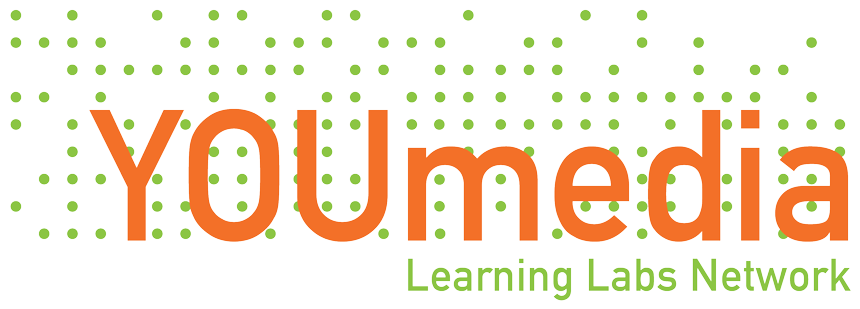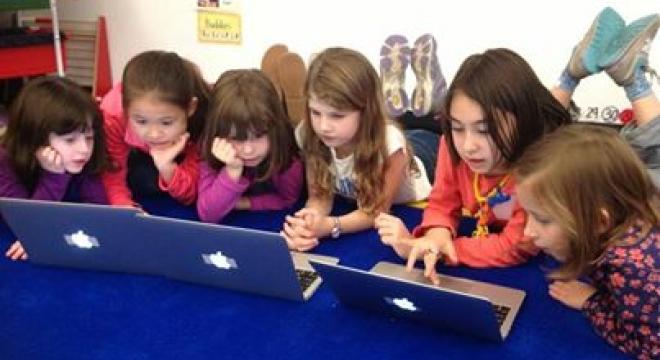From Miami through the Midwest, YOUMedia sites and Learning Labs hosted Hour of Code workshops that left participants hungry for more. Whether their events drew eight teens or more than 400, organizers credited advance preparation and engaging tutorials with sparking teens’ interest in mastering the languages that power the games and media they love.
“It was awesome. I loved it and it was a great chance for me to learn about computer science.”
“I want to do it again, every day.”
These comments from young people who participated in YOUMedia Miami’s Hour of Code workshop speak for hundreds of youth across the country who participated in Hour of Code 2013 events sponsored by YOUMedias and Learning Labs. The Hour of Code was launched this year as part of Computer Science Education Week, during which more than 17 million students spent at least one hour learning about computer programming, according to the nonprofit code.org.
In Miami, YOUMedia staff set up four breakout tables through which the 25 participants—including two adults—could rotate: a video introduction to coding from code.org, followed by opportunities to code and create using AppInventor, Scratch, and even the wildly popular game Minecraft. “Many of the teens did not want to stop creating and producing, even when the Hour of Code event had ended,” said Marlon Moore, library media project coordinator for YOUMedia Miami. This was true even though most had no prior experience with coding. Next time, Moore added, they’ll plan on more than an hour, so that participants can go deeper with their practice and projects.
In Chicago, the YOUMedia partner Digital Youth Network collaborated with DePaul University’s College of Computing and Digital Media to offer a taste of code to about 415 young people from about a half dozen Chicago Public Schools. “I didn’t even know anything about coding” before coming to DePaul, said Julian Murdoch, a 7th grader at Chicago International Charter School’s Wrightwood campus on Chicago’s South Side. “It was easy and it looks like it would be helpful in the future.”
Some of their instructors found Hour of Code to be a learning experience, too. Though he had previously worked with websites, “as an instructor I had never really coded before,” said Brother Mike Hawkins, youth engagement coordinator for Digital Youth Network. Hawkins found it valuable to struggle with the same challenges the students would encounter by trying out the tutorials in advance. Having mastered the challenges, Hawkins was able to tell first-time coders, “The hour of code took me an hour and 30 minutes—don’t feel bad if you are struggling.”
On Wednesday, December 11, a group of 8th graders from Moos Elementary in Chicago’s West Town neighborhood came to DePaul and tackled the challenge of creating animated, interactive holiday cards using Scratch. Though each student made an individual card, most paired up with a neighbor or two to solve problems and enjoy each other’s creations. The Scratch holiday card was a popular entry into coding in Chicago and elsewhere. Scratch’s graphical blocks make it easy to string commands together and create loops that make characters move and speak.
Though Chicago Public Schools officials pledged to make computer science a graduation requirement during Computer Science Education Week, programming is far removed from most students’ current educational experience, especially before high school. “We mostly use the computers for word processing, internet research, presentations. We haven’t done any coding activities,” said Moos teacher Kerrin Staskawicz. “This is a nice exposure to a world of new possibilities.”
For some students, those new possibilities also included being on a college campus for the first time. Students took a quick tour of the facility, including a peek at the game lab—DePaul offers a major in game development—which wowed some of the young visitors. Hawkins also took special care to recruit women volunteers, including Denise Nacu, an instructor in DePaul’s Interactive and Social Media Program. “It was especially important that [girls] could see women who code” and begin to imagine themselves pursuing it as a career, said Hawkins. “I heard a lot of girls reflecting on that.”
While most participating sites recruited youth to come to them, staff from the Kansas City Public Library went to Crossroads Academy, a nearby charter school, to introduce 5th and 6th graders to code. “I was told the students in my class were typically less motivated…but my observation was the students were totally engaged,” said Andrea Ellis, digital youth engagement manager for the library. “I heard a couple of them say, ‘I can’t do this!’ But we had enough adult support that one of us was able to jump in immediately and give them one-on-one attention until they accomplished their goal.” For the 36 students participating, having nine adults present—five library staff plus four teachers—made a big difference, Ellis observed.
Even the smallest events had surprisingly large effects. In Thornton, Colorado, 11 miles north of Denver, the Anythink Huron Street Library hosted an Hour of Code event for eight young people in middle and high school. In this tech-rich area,youth created video games using Tynker and learning apps using Hopscotch. Though this branch does not have a formal YOUMedia-style space, their flexible program area, laptops, and iPads made a welcoming home for the Hour of Code. Within a week, four of the eight participants returned to the library to show teen guide Genne Boggs additional projects they had completed after the Hour of Code ended.
The Hour of Code whetted the appetites of millions of young people to learn more about coding, and YOUMedias and Learning Labs are likely to help feed their desire. YOUMedias like Chicago’s that were unable to take part in Hour of Code, are looking for ways to bring coding opportunities to their youth through partnerships. Code.org also offers a 20-hour course introducing computer science to elementary students that serves as a main course to follow the Hour of Code appetizer. More tutorials can be found here.
By Maureen Kelleher
Photo courtsey of Code.org

